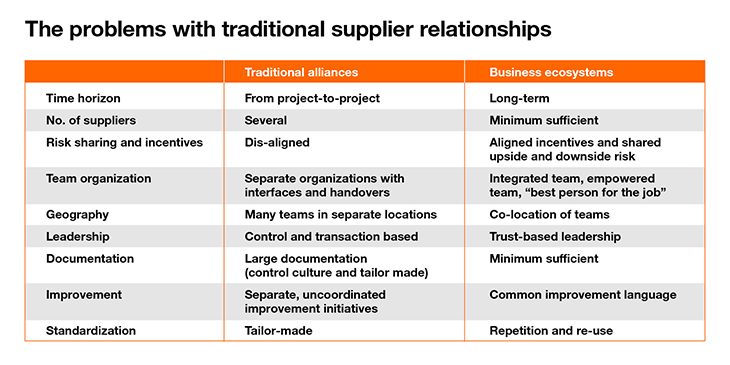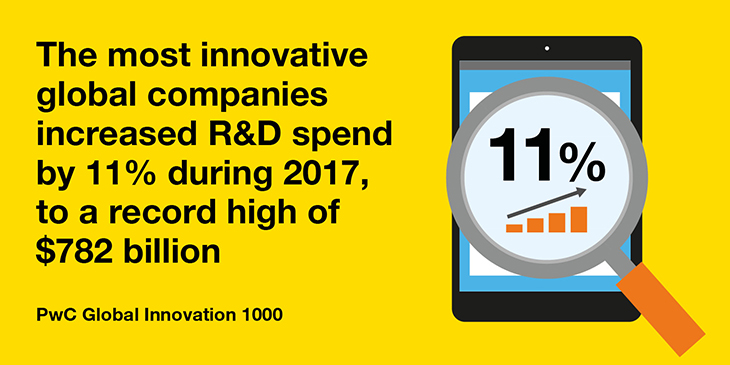Shifting industry boundaries mean that change is happening faster than ever and coming at us from all directions. In a world where every business wants to be digital, it’s becoming harder to keep up by innovating alone. Enterprises are increasingly seeking out new ideas externally and internally in their quest to bring more integrated and intuitive products and services to market. Co-innovation – which involves the sharing of risks and rewards and often includes the development of joint commercialization plans – is increasingly the favored approach.
The benefits are clear. By bringing in fresh perspectives and skills from varied external partners, you’re better able to anticipate and meet many different customers’ needs faster all around the world. Technology has now become so specialized that nobody can afford to do everything at the highest level, and you have to partner to excel.
For example, car makers realize that it’s better to join together with specialist technology firms and then later go on to compete in the marketplace when developing more efficiency batteries, driver-less cars or urban mobility services. Sometimes the focus is just a single project. At the other end of the scale, competitors, like BMW and Daimler, actually set up a joint venture company to co-innovate.
In financial services, we’re seeing the rise of open banking ecosystems. The use of open APIs allows third-party developers to build applications and services around financial institutions and increase financial transparency options for account holders. Using APIs means that banking data is available in real time, providing consumers with better ways to conduct transactions, save and invest their money. Consumers may also have access to better loan terms since lenders will be able to look at historical transactional data to determine a borrower’s risk level.
Orange has a rich history of co-innovation. For example, it co-developed an IoT-based fuel monitoring system with Russian fishing fleet operator Dobroflot to optimize fuel consumption and help prevent unauthorized fuel usage. The savings being made are having a significant impact on Dobroflot’s bottom line, as around half of a vessel’s operating costs are related to fuel.
Another example is a chatbot for automating many IT help desk tasks, co-developed by the International Red Cross and Business & Decision, an Orange Business company. And there is an “automated suspicious email analysis tool” that crowd sources intelligence on suspecting phishing emails that have slipped through other security defenses and automatically deletes them from employees’ in-boxes. This was developed in partnership with a major oil and gas firm.
What to look for in a co-innovation partner
Co-innovation is very distinct from the “build it and they will come” approach to developing off-the-shelf products and services. Previously, there was the tendency to assume everyone understood the problem they needed to solve. In reality, there can be ambiguity around the scope of a problem, multiple paths to resolving it and the need to anticipate new problems customers will face in the future.
A CX/UX-led (customer experience and user experience led) approach, which includes customer journey mapping, is the starting point for any co-innovation program. Truly listening and being open to what the customer is saying – including if it is not what was expected – are key.

Working with start-ups
For a large enterprise, it can be a real headache ensuring a start-up is robust enough to be in the game for the long term and to scale to meet their ongoing needs. For this reason, Orange Fab identifies start-ups with the most mature, leading-edge technologies and carries out extensive due diligence, while Orange Digital Ventures takes a financial stake in the most promising companies around the world.
For example, originally accelerated in the Orange Fab program and now part of our Orange Cloud Starter program, the start-up Smartly.ai specializes in AI for chatbots. We’ve already co-developed custom chatbots, including for the French Presidency and French National Pension Fund.
Open Labs for out-of-the-box thinking
An “open lab” can offer real benefits for organizations, for example, reinforcing corporate commitment to innovation and creativity in a physical space. Car maker BMW has a co-creation lab where its customers can share their ideas and become an integral part of concept vehicle development.
Orange has 14 R&D centers worldwide, including Orange Gardens in Paris. Although the physical design of the space is central to its functionality – emphasizing dislocation from day-to-day activity, eliminating hierarchy and encouraging participation – direct facilitation by skilled business consultants remains critical to success.

Create co-innovation workspaces
One of the key challenges is that enterprises need a communication platform that enables opportunities and ideas to find each other – where people can contribute, regardless of whether they are employees, contractors, users, partners, suppliers or virtual communities.
Social enterprise networks enable you to find the known and unknown experts in your organization with rapid search, rich skills profiles and powerful networking capabilities. Orange specializes in developing social enterprise networks and collaboration environments in which you can securely work with contributors from external organizations with robust, fine-grained privacy and access controls. Activity streams keep employees updated, and the platform provides a window into existing document management tools.
Dual explore and exploit capabilities
Orange is one of the few companies undertaking fundamental and applied research as part of its co-innovation capabilities. It has dual “explore” and “exploit” capabilities. It’s not that one is better than the other – you need both because ideas need to work and be supported in the real world, and there are many hurdles to cross to make that happen.
Creating business ecosystems
A co-innovation program may evolve into a permanent partnership with all parties playing a role in servicing the end customer on an ongoing basis. It’s important to ensure you have the requisite control over ecosystem data, workflows and security of all players in this business ecosystem.
Find out how to co-innovate with Orange in the IoT arena.
